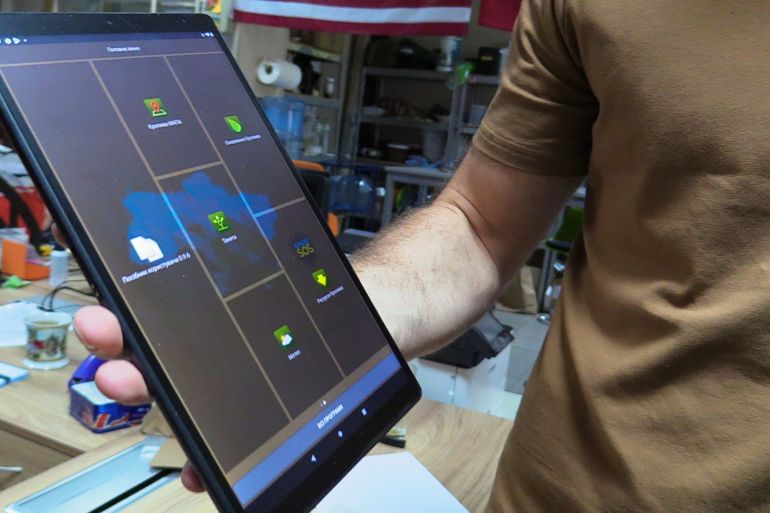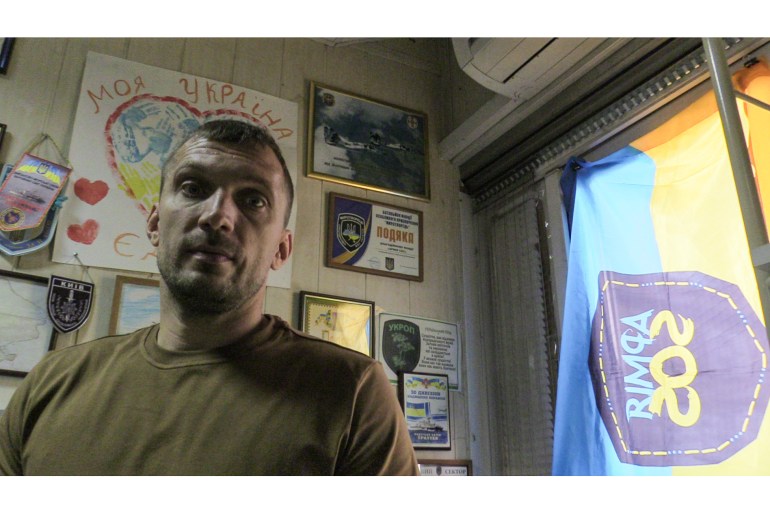How Ukraine turns cheap tablets into lethal weapons
Army SOS, an activist-led NGO, converts Android-based tablets into smart units with automated precision guidance.

Kyiv, Ukraine – Years before Russia invaded Ukraine, Oleksiy Savchenko helped develop one of the most lethal and inexpensive weapons now used by thousands of Ukrainian service members.
In 2014, he was among the protesters whose months-long rallies in Kyiv ultimately removed pro-Russian President Viktor Yanukovych.
Keep reading
list of 4 itemsBelarus congratulates Ukraine on Independence Day
Russia arrests ex-mayor for ‘discrediting’ army amid Ukraine war
On Ukraine’s Independence Day, UN urges end to ‘senseless’ war
In revenge, Moscow annexed Crimea and stoked a separatist war in Ukraine’s southeast. This led Savchenko, together with like-minded activists, to start a non-governmental organisation called Army SOS.
The group raised money to procure flak jackets and other military gear for former protesters who volunteered to fight the separatists despite being under-equipped and barely trained.
And as the group delivered the gear to the front line, the volunteers and service members asked for something they needed badly.
“Guys, give us maps, we need maps, we only have Soviet ones from the 1980s. Where there used to be a field is now a village or an apartment building,” Savchenko recalled them saying.
But instead of printing thousands of pages, Army SOS went for a tech solution.
They asked a group of software developers in Kyiv to install satellite maps and Ukrainian military data on tablets and smartphones.
According to a Ukrainian service member who responded to the novelty in 2014, troops started seeing their surroundings better, and the tools allowed them to correct artillery more clearly and precisely.
More suggestions were passed on.
“Can you add an option to measure distance? Can we enter coordinates? Can we guide and calculate artillery fire?” were the most important ones, Savchenko told Al Jazeera.
The Soviet-era way of guiding fire requires manual data entry and the use of artillery tables for calculations that take up to 15 minutes.
But what Army SOS and the developers came up with changed the entire system.
Named Kropiva (nettle), the software is part of a series of hi-tech equipment and weaponry that has helped to transform the Ukrainian military from a demoralised underdog to a serious force of resistance.
Kropiva “is an example of a private initiative and an effective use of civilian systems in the military,” Pavel Luzin, a Russia-based defence analyst with the Jamestown Foundation, a think tank in Washington, DC, told Al Jazeera.

The software turns any Android-based tablet that costs $150 or more into a basic unit of an automated precision guidance system.
The tablet can acquire and transmit coordinates for correcting artillery fire from its user, a drone or a radar.
It can calculate the distance to targets and direct shots of each type of artillery used in the Ukrainian military.
The tablet also gets meteorological data that can affect each shot – the speed and direction of wind, temperature and humidity.
If there is no web access to get in touch with command centres, the tablet can use portable radio stations.
The calculations are made and transmitted within seconds – time that can save lives and destroy the enemy.
“It’s fast and precise,” Savchenko said sitting in the group’s office in central Kyiv, crammed with boxes with new tablets and decorated with flags of Ukrainian military units signed by thankful service members.
The tablet also saves lives in other ways.
“People came to a minefield. And came out alive” using a tablet with Kropiva, Antonina Baiura, a volunteer with the group, told Al Jazeera.
Army SOS and the developers handed the software code over to the Ukrainian military free of charge in 2018.
Competing approaches
Each tablet is like a worker bee in a hive.
It contains information only about its user’s immediate surroundings. If seized, the password-protected tablet can be rendered digitally dead from a server.
And even if Russian or separatist service members get hold of an operating tablet, their superiors strongly recommend not to use it.
“One can find free cheese only in a mouse trap. The trophy Ukrainian software is such a mouse trap,” a Russian military publication, Top War, warned in May.
The article’s anonymous author alleged that data from each tablet ends up in the United States – and that entering Russian maps will provide the enemy with crucial information.
The publication also lamented the absence of similar software in the Russian military.
“Even if such software exists, it hasn’t been supplied to front-line military units,” the author concluded.
This conclusion underlines the evolutionary difference between the ways Russia and Ukraine develop new weaponry.
Russia’s military-industrial complex is mired in corruption and ineffectiveness, along with inflated budgets and an opaque contracting system, analysts say.
A Kropiva is barely possible in Russia because its military-industrial complex “is too clumsy and is burdened by the mass of intelligence officers that live off it as parasites,” analyst Luzin said.
“Analogues [of Kropiva] are possible, but they will be many times more expensive and far less useful and effective,” he said.
Transparency reforms
Ukraine has also inherited a chunk of the Soviet military-industrial complex.
More than a hundred arms developers and producers form Ukroboronprom, a state-run conglomerate, where corruption was so notorious that it prompted criticism from Washington.
“It serves no purpose for Ukraine to fight for its body in Donbas if it loses its soul to corruption,” Rex Tillerson, the then-US secretary of state, said in 2016.
These days, Ukroboronprom is undergoing a painful transition to transparency as its plants and research bureaus are targeted by Russian cruise missiles.
Unlike their adversaries, the Ukrainian military prefers not to trumpet brand-new, domestically-developed weaponry.
The defence ministry even urged Army SOS to stay away from mass media.
“The military asked us to get off the radar and not to be in the limelight,” Savchenko said. “But they don’t have an answer to [our] question about where we would get the money to fund the projects.”
According to Savchenko, articles about his initiative have previously led to donations.
These funds have already helped buy thousands of tablets and smartphones, and there is a waiting line of up to four days for service members who want Kropiva installed on their devices.
Army SOS protects the identities of its volunteers, software developers and the service members who use Kropiva.
“I am just a talking head. If I get killed, the process will go on,” Savchenko said.
The volunteers around him are civilians who never planned to work with the military – and will return to their daily lives after the war.
“We end the war with a victory,” he said, “and go back to our jobs.”